
The spider genus Steatoda, in the family Theridiidae, includes about 120 recognized species, distributed around the world. One common name is cupboard spider, for many species build their webs in dark, sheltered, undisturbed places around the house or garden, in sheds and garages, under garden, in compost bins, and the like. Signs of the cupboard spider include small white spots of spider droppings, like small splashes of paint, on the floor underneath the web.
Avaruarachne is a genus of jumping spiders containing the single species Avaruarachne satchelli. The species was first described by Brian John Marples in 1955 as Avarua satchelli, but Avarua was discovered to be preoccupied and was replaced by Avaruarachne by Danniella Sherwood in 2021. It has only been found in the Cook Islands.

Neriene is a genus of sheet weavers that was first described by John Blackwall in 1833.
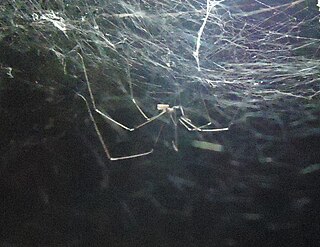
Crossopriza lyoni is a widespread species of cellar spiders that prefer to live in or around human structures. They are commonly known as tailed cellar spiders, tailed daddy longlegs spiders, and sometimes box spiders. They all possess extremely long fragile legs that can reach up to 6 cm (2.4 in) long and a body length of that ranges from 2.5 to 7 mm. Their abdomens are distinctly squarish when viewed from the side and their carapace is more or less circular when viewed from above. They also possess two kinds of sound-producing organs and have six eyes.
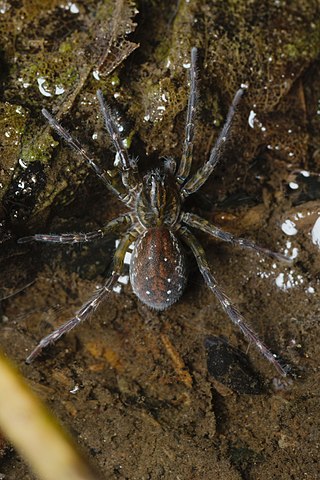
Piratula is a genus of wolf spiders first circumscribed in 1960. Its 26 species are found mainly in Asia, with a few found in Europe and North America.

Bathyphantes is a genus of dwarf spiders that was first described by Anton Menge in 1866.
Myrmage dishani is a species of spiders of the genus Myrmage. It is endemic to Sri Lanka. The species was first found from Eastern part of Sinharaja Forest Reserve. The species can easily identified by the round opisthosoma, without any visible, constrict. However, the species is much similar to Myrmage imbellissyn.: Myrmarachne imbellis.
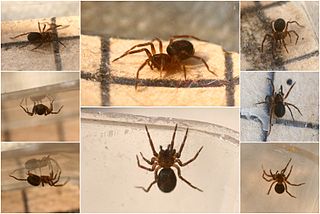
Iberina is a genus of dwarf sheet spiders that was first described by Eugène Simon in 1881.

Scotina is a genus of sac spiders of the family Liocranidae which was named by the German zoologist Franz Anton Menge in 1873 with Scotina gracilipes as the type species. Scotina was thought to be a mainly Western Palearctic genus but one species, Scotina palliardi was found in Korea in 2011. The species in the genus Scotina are small spiders which have six to ten pairs of ventral spines which can be seen using a lens. They have a darker and shinier cephalothorax than in other genera within the Liocranidae. They also have light brown femora with the more distal segments of the legs are darker, especially on the first pairs. They are terrestrial spiders which are mainly found among moss and litter on the ground.

Lathys is a genus of cribellate araneomorph spiders in the family Dictynidae, and was first described by Eugène Simon in 1884. It is a replacement name for "Lethia" Menge, 1869 because that name was already in use as a synonym for a genus of moths.

Araeoncus is a genus of dwarf spiders that was first described by Eugène Louis Simon in 1884. They closely resemble members of Diplocephalus; both genera have a uniquely shaped of the cephalothorax and a species-specific modification of the tibial apophysis of the pedipalp.

Erigonella is a genus of dwarf spiders that was first described by David B. Hirst in 1901.

Helophora is a genus of dwarf spiders that was first described by Anton Menge in 1866.

Parapelecopsis is a genus of dwarf spiders that was first described by J. Wunderlich in 1992. The spider is found in woodlands in leaf litter, pine needles, moss at ground level and lichen and moss on tree trunks.

Saaristoa is a genus of sheet weavers that was first described by Alfred Frank Millidge in 1978.

Centromerus sylvaticus is a species of sheetweb spider in the family Linyphiidae. It is found in North America, Europe, Turkey, a range from Russia, China, Korea, and Japan.
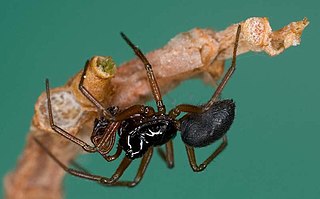
Erigone atra is a species of dwarf spider or money spider, in the family Linyphiidae. It is commonly found in North America, Europe, parts of Russia, Central Asia, China, Mongolia, Korea, and Japan. This spider is one of the most common Erigone spiders. E. atra is an important spider for agriculture, as it preys on pests such as aphids which are commonly found on crops. E. atra spiders are aeronautical spiders, as they travel via ballooning. This technique, sometimes referred to as kiting, allows E. atra spiders to traverse large distances and find new habitats when environmental or human stresses create unfit living environments. E. atra is difficult to differentiate from other congeneric species because of their similar sizes and coloring.

Wilhelmus Egbertus Antonius Janssen, better known as Father Chrysanthus OFMCap, was a Dutch priest and biology teacher. He was known for his studies in arachnology. Initially he was concerned with the spiders of the Netherlands but he became a specialist on New Guinea spiders. Two spider species were named in his honor following his death.
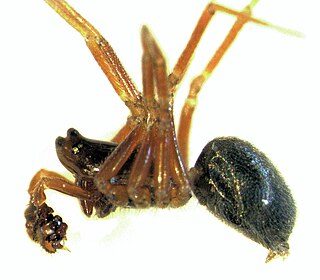
Diplocephalus cristatus is a species of sheet weaver spider.

















